
A straw man (ritual doll) is a dummy in the shape of a human usually made up entirely out of straw material, or created by stuffing straw into clothes.

A straw man (ritual doll) is a dummy in the shape of a human usually made up entirely out of straw material, or created by stuffing straw into clothes.
Straw men are commonly used as scarecrows, combat training targets, swordsmiths' test targets, effigies to be burned, and as rodeo dummies to distract bulls.
In the sport of rodeo, the straw man is a dummy, originally made of a shirt and pants stuffed with straw. The straw man is placed in the arena during bullriding events as a safety measure. It is intended to distract the bull after the rider has dismounted (or has been thrown), with the idea that the bull will attack the straw man rather than attack its former rider. Two so-called rodeo clowns – people dressed in bright colors whose job it is to distract the bull if the rider is injured – are in the ring as well and are usually far more effective than the straw man.[ citation needed ]

A straw man fallacy is the informal fallacy of refuting an argument different from the one actually under discussion, while not recognizing or acknowledging the distinction. One who engages in this fallacy is said to be "attacking a straw man".

Rodeo is a competitive equestrian sport that arose out of the working practices of cattle herding in Spain and Mexico, expanding throughout the Americas and to other nations. It was originally based on the skills required of the working vaqueros and later, cowboys, in what today is the western United States, western Canada, and northern Mexico. Today, it is a sporting event that involves horses and other livestock, designed to test the skill and speed of the cowboys and cowgirls. American-style professional rodeos generally comprise the following events: tie-down roping, team roping, steer wrestling, Steer roping, saddle bronc riding, bareback bronc riding, bull riding and barrel racing. The events are divided into two basic categories: the rough stock events and the timed events. Depending on sanctioning organization and region, other events such as breakaway roping, goat tying, and pole bending may also be a part of some rodeos. The "world's first public cowboy contest" was held on July 4, 1883, in Pecos, Texas, between cattle driver Trav Windham and roper Morg Livingston.

Bull riding is a rodeo sport that involves a rider getting on a bucking bull and attempting to stay mounted while the animal tries to buck off the rider.

Bronc riding, either bareback bronc or saddle bronc competition, is a rodeo event that involves a rodeo participant riding a bucking horse that attempts to throw or buck off the rider. Originally based on the necessary buck breaking skills of a working cowboy, the event is now a highly stylized competition that utilizes horses that often are specially bred for strength, agility, and bucking ability. It is recognized by the main rodeo organizations such as the Professional Rodeo Cowboys Association (PRCA) and the International Professional Rodeo Association (IPRA).

A rodeo clown, bullfighter or rodeo protection athlete, is a rodeo performer who works in bull riding competitions. Originally, the rodeo clown was a single job combining "bullfighting" — the protection of riders thrust from the bull, as well as being an individual who provided comic relief. Today, the job is split into two separate ones: bullfighters who protect the riders from the bull, and entertainers (barrelmen) who provide comic humor. However, in some parts of the world and at some small rodeos, the jobs of bull rider protection and comic remain combined.

Bodacious #J-31 was an American bucking bull. He was known throughout the rodeo world as "the world's most dangerous bull". He was also known as "the greatest bull ever to buck". During his rodeo career, he was the 1994 and 1995 Professional Rodeo Cowboy Association (PRCA) Bucking Bull of the Year, as well as the 1995 Professional Bull Riders (PBR) World Champion Bull. He and Bruiser are the only bulls who have won bucking bull world championship titles in both organizations.
The National Finals Rodeo (NFR) is the premier rodeo event by the Professional Rodeo Cowboys Association (PRCA). The NFR showcases the talents of the PRCA's top 15 money winners in the season for each event.
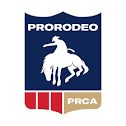
The Professional Rodeo Cowboys Association (PRCA) is the largest rodeo organization in the world. It sanctions events in the United States, Canada, and Mexico, with members from said countries, as well as others. Its championship event is the National Finals Rodeo (NFR). The PRCA is headquartered in Colorado Springs, Colorado, United States.
A straw man is a form of argument and an informal fallacy.
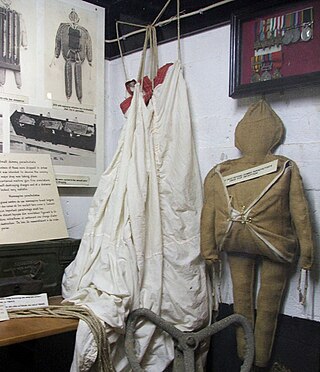
A paradummy is a military deception device first used in World War II, intended to imitate a drop of paratroop attackers. This can cause the enemy to shift forces or fires unnecessarily, or lure enemy troops into staged ambushes.
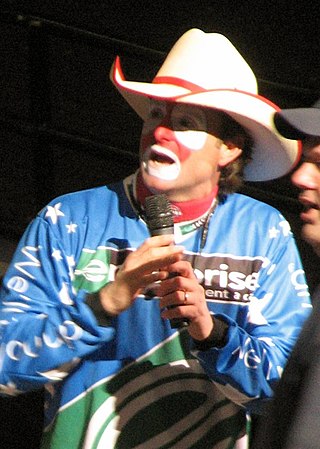
Flint Rasmussen is an American television sideline reporter for the Professional Bull Riders. Previously, he was a professional rodeo barrelman for many years. He is perhaps the most famous barrelman in the history of bull riding. He currently resides in Billings, Montana, United States.

A mechanical bull, also known as a bucking machine, is a device that replicates the sensation of riding a bucking animal, such as a rodeo bull or horse, popularized by Sherwood Cryer. It is usually powered by a variable-speed electric motor. Padded flooring is often installed around the equipment in order to reduce the likelihood of injury to those thrown off it.

Steer riding is a rodeo youth event that is an introductory form of bull riding for younger riders, usually between the ages of seven and fourteen. Instead of bucking bulls, the children ride steers that buck. Steers are used because they are known to have a less volatile temperament than bulls and many breeds weigh less than bulls, which makes them a perfect stepping stone to junior bulls. The steers usually weigh between 500 and 1,000 pounds. Steer riding usually follows mutton busting and calf riding as the participant ages and grows. Many young and aspiring bull riders who train in steer riding compete in the National Junior Bullriders Association.
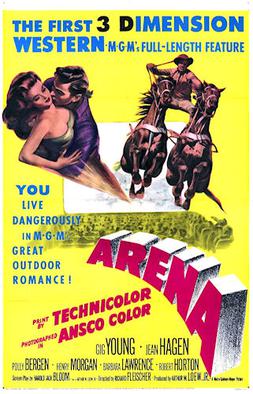
Arena is a 1953 Ansco Color 3-D film directed by Richard Fleischer and starring Gig Young, Jean Hagen, and Polly Bergen. It was promoted as "the first 3-D Western" of the era.
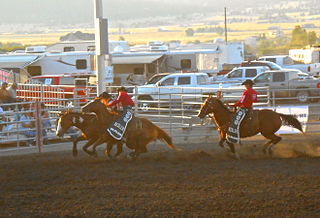
A pickup rider is a person on horseback who works at a rodeo in the rough stock competitions of bull riding, saddle bronc and bareback riding. Pickup riders play an important role in assisting rodeo riders and increasing the safety of competitors.

A bucking bull is a bull used in rodeo bull riding competition. They are usually a Brahman crossed with another breed, weighing 1,500 pounds or more, selected for their tendency to "leap, plunge and spin" when a human is on its back. Circa mid-20th century breeders began selecting bulls for bad temperament, that would buck when ridden. Many of the best bucking bulls trace their lineage to bulls owned by Charlie Plummer of Oklahoma. These are known as Plummer bulls.

The Bull Riding Hall of Fame, located at Cowtown Coliseum in the Fort Worth Stockyards in Fort Worth, Texas, United States, is a hall of fame for the sport of bull riding. It is incorporated as a non-profit organization in the State of Texas, and created to "recognize, memorialize, and applaud the bull riders, bullfighters, bulls, stock contractors, events, and individuals who have made a historic contribution and attained stellar performance in the sport." Membership is open to fans worldwide.

V-61 was a hall of fame bucking bull known only by his brand, V-61. In 1970, he was the Bucking Bull of the NFR. In 2012, the Texas Rodeo Cowboy Hall of Fame inducted V-61. In 2015, the Bull Riding Hall of Fame inducted him into its inaugural class. In 930 attempts, only four bull riders managed to complete rides on him for a total of five qualified rides. His owner retired him in January 1974 and he died later that year.
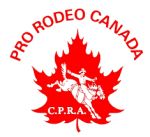
The Canadian Professional Rodeo Association (CPRA) is the governing body of professional rodeo in Canada. Its championship event is the Canadian Finals Rodeo (CFR) held every November.

American Bucking Bull, Inc. (ABBI) is an organization dedicated to the registration of bucking bulls and establishing the American Bucking Bull as a documented breed of cattle. American Bucking Bull, Inc., is owned by the Professional Bull Riders (PBR) and stock contractors. The organization created a breed registry and manages the registration and certification of American Bucking Bulls. It also keeps records of other breeds of bulls, some of which died out many years ago. It is the largest organization performing these functions. It maintains a genetic DNA database, manages bucking bull pedigrees and encourages the growth of the breed. ABBI also holds competitions for bucking bulls ages 2 through 4. It also has its own magazine, the American Bucking Bull.